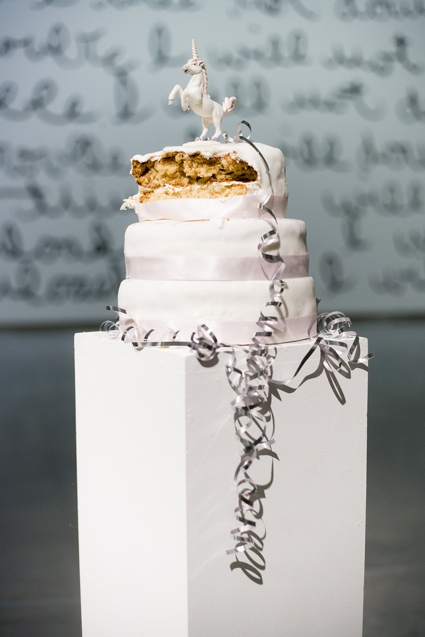 Addie Wagenknecht, At least we tried, 2014. Photo ©Joseph Carr
Addie Wagenknecht, At least we tried, 2014. Photo ©Joseph Carr
If you’re in Dublin or anywhere near it, then this week is your last chance to see GLITCH 2014. Cash Rules Everything Around. GLITCH is Dublin’s digital and new media art festival and the title of this year’s edition is directly inspired by New York hip hop group Wu-Tang Clan’s single C.R.E.A.M Cash rules everything around me.
The exhibition examines how artists use new media to investigate social and political systems to find their position within and in relation to these larger systems. In this fuzzy zone of information production, where boundaries and roles are increasingly blurred, the exhibition deploys humour and critique to reconfigure our ideas about our current digital economic climate.
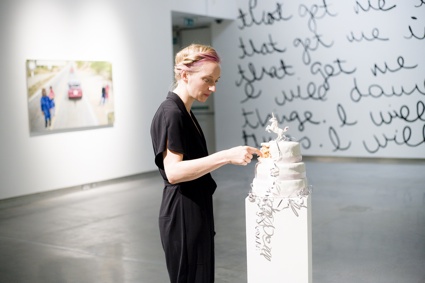 Addie Wagenknecht cutting a piece of ‘At least we tried’. Photo ©Joseph Carr
Addie Wagenknecht cutting a piece of ‘At least we tried’. Photo ©Joseph Carr
The main gallery hosts a solo exhibition of Addie Wagenknecht. In a series of brand new commissions, the artist explores the topic of the festival under the ‘internet angle’, revealing how money voraciously seeps in and out of the internet.
Ironically, the backdrop of the exhibition is one that everyone working in the cultural sector is all too familiar with: the lack of funding. But if you’re Wagenknecht, you don’t let that stop you, you turn the limitation into a full-on exercise in alternative economies, authorship and nifty outsourcing.
The most thought-provoking result of the challenge is a series of paintings titled ‘Outsourced Outsourcing.’ First, the artist looked online for the most popular images associated with Google Street View. Amusingly, some of them were famous screenshot that Jon Rafman took of his computer screen for his photo project The Nine Eyes of Google Street View. She then downloaded and emailed the photos along with a few instructions to the manager of a painting factory in China. Asked whether she wanted painting of low, medium or high quality, she opted from “medium.” A few months later, DHL shipped the works to Ireland. Upon arriving at the gallery the paintings were stretched and mounted onto canvases and subsequently hung under the direction of the curator.
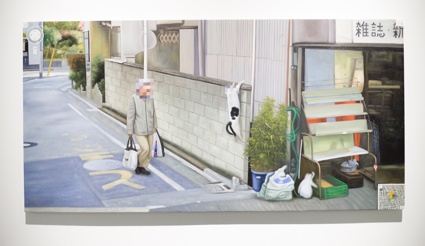 Addie Wagenknecht, Outsourced views, Search result # 3, 2014. Photo ©Joseph Carr
Addie Wagenknecht, Outsourced views, Search result # 3, 2014. Photo ©Joseph Carr
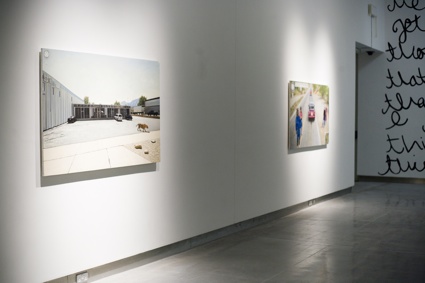 Addie Wagenknecht, From left to right: Outsourced views, Search result #1 and Outsourced views, Search result # 2. Photo ©Joseph Carr
Addie Wagenknecht, From left to right: Outsourced views, Search result #1 and Outsourced views, Search result # 2. Photo ©Joseph Carr
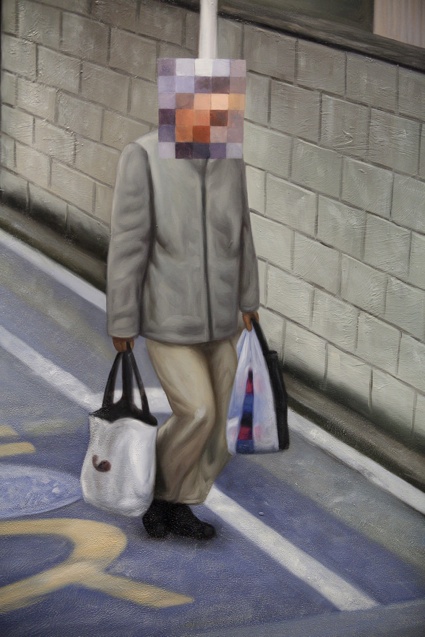 Addie Wagenknecht, Outsourced views, Search result # 3 (detail), 2014. Photo ©Joseph Carr
Addie Wagenknecht, Outsourced views, Search result # 3 (detail), 2014. Photo ©Joseph Carr
So, it appears as if Wagenknecht didn’t do anything. She never touched the canvas (but then neither do Takashi Murakami or Damien Hirst these days.) She even let google dictate the subjects of the paintings and discovered her own work as she entered the exhibition. But if Wagenknecht can afford to delegate every step of the creation and exhibition process, it is because she is an artist with a deep and playful understanding of some of today’s most exciting issues in both art and society: the mechanisms of the intangible, the faith in data and processes, and also the critique of the notion of authorship:
In an interview with Totally Dublin, the artist explained: There’s a romance and fascination in my generation with forgery, copies and bootlegs. It’s a question of what is the original: the .mp3 I purchased on the iTunes store or the same .mp3 I downloaded from The Pirate Bay? Is the iTunes version the original because a corporation tells me it is, or is the one from The Pirate Bay the original because my friends tell me it is?
We are a generation that was born and grew along with the .mp3, Napster and Pirate Bay. I want to divorce the experience of art from authentication of the brand of the artist; the power of the artist name, our social investment in the concept of genius and of ownership of an idea, a shape, or colour. The certainty that something is real – is that even a possibility anymore? Forgery embraces fantasy. It is disruptive to the system, which is something art is supposed to do.
The work that hit me as i entered the room was a vanilla-smelling and candy-coated wedding cake masterfully baked by curator Nora O Murchú for the show (it was the first time in my life i met with a curator who can both code and bake.) What remains of the cake should still be there for people to eat and share and is surmounted by a unicorn ordered from Amazon. An internet icon topping a symbol of women’s ultimate dreams and hopes.
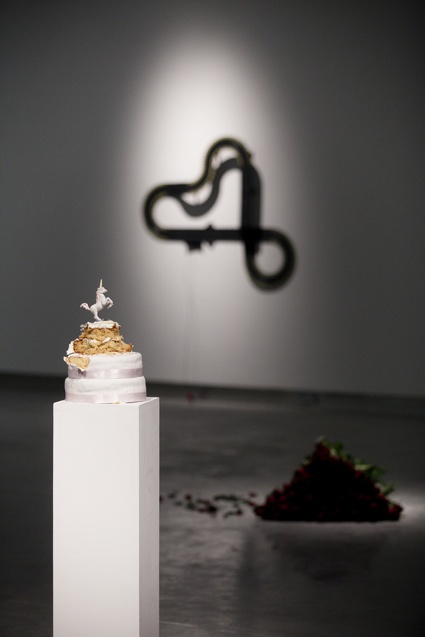 General view of the exhibition space. Photo ©Joseph Carr
General view of the exhibition space. Photo ©Joseph Carr
Toy cars, once again ordered from Amazon, come crashing at the base of the cake podium. “Everything you ever wanted.” The arc of the little red vehicle references Guo-Qiang’s 99 taxidermy wolves. The car crash provides a dramatic ending to the futile race that takes place on a wall nearby where Scalextric tracks, purchased this time from eBay, have been installed vertically, a controller dangling at one end.
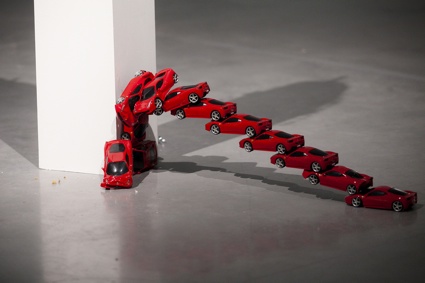 Addie Wagenknecht, Everything you ever wanted. Photo ©Joseph Carr
Addie Wagenknecht, Everything you ever wanted. Photo ©Joseph Carr
Two opposite walls in the exhibition echo contemporary worries in the most ironically joyful way. On the one side, 30 CCTV cameras keep a sparkling eye on gallery visitors. The cameras purchases from Chinese marketplace Alibaba and then wrapped with crystals in gallery by technicians reflect the “grown up” state of the Internet. A glamorous take on surveillance devices which ubiquity we’ve long taken for granted.
On the other side of the room, the handwriting of the artist repeats over and over a dilemma of our times: “I will not download things that will get me in trouble” until the words turn into “I will download things”. Should you download for immediate personal satisfaction (and thus risk being punished if ever your ‘act of piracy’ is discovered by the apparatus of online surveillance)? Or should you act like a ‘responsible’ citizen and abide by the laws?
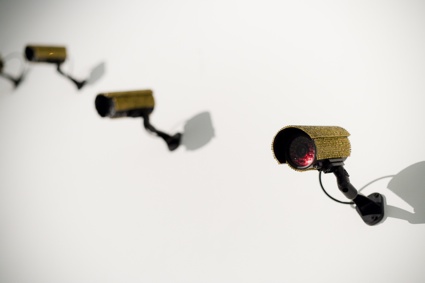 Addie Wagenknecht, Loves lies. Photo ©Joseph Carr
Addie Wagenknecht, Loves lies. Photo ©Joseph Carr
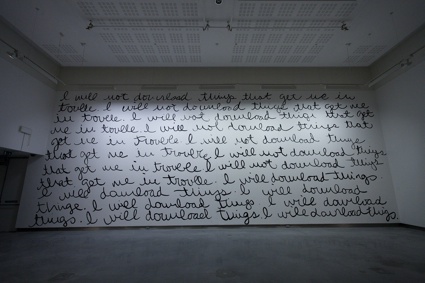 Addie Wagenknecht, Everything I know, then some. Photo ©Joseph Carr
Addie Wagenknecht, Everything I know, then some. Photo ©Joseph Carr
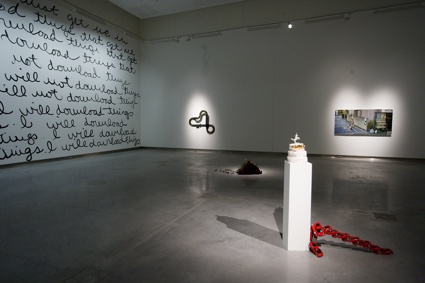 General view of the exhibition space. Photo ©Joseph Carr
General view of the exhibition space. Photo ©Joseph Carr
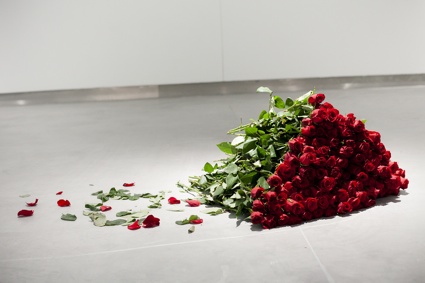 Addie Wagenknecht. Photo ©Joseph Carr
Addie Wagenknecht. Photo ©Joseph Carr
The other gallery showed works by two Irish artists:
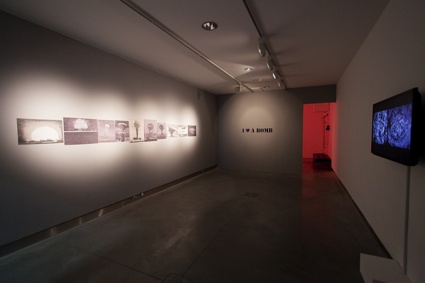 Entrance to the other gallery. Photo ©Joseph Carr
Entrance to the other gallery. Photo ©Joseph Carr
In her video installation The Pit, Breda Lynch used a short sequence from Anatole Litvak‘s 1948 film The Snake Pit. The film takes its name from a dream made by the main character, Virginia (played by Olivia de Havilland.) The character finds herself surrounded by other patients of the mental asylum where she is staying. The place is very crowded and she seems desperate to escape. Slowly, the camera starts to move upwards from the ground until the patients appear as tiny, nervous dots. Like reptiles in a pit.
Lynch muted the video, splits the screen in two and loops two channels as one sequences – the left-hand frame features the original sequence, the right-hand one simultaneously plays the same sequence in reverse. The result is a hypnotizing and communicate a feeling of anxiety and disequilibrium. As the curator’s text explained, the images are visually reminiscent of a Wall Street Trader’s pit, whilst conjuring up values of fear-driven greed, exploitation, and hyper-consumption.
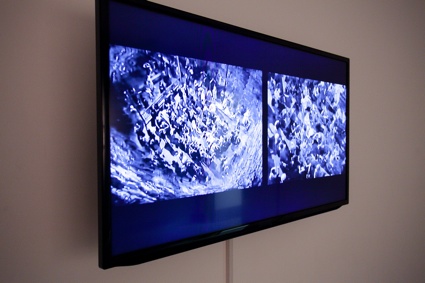 Breda Lynch, The Pit
Breda Lynch, The Pit
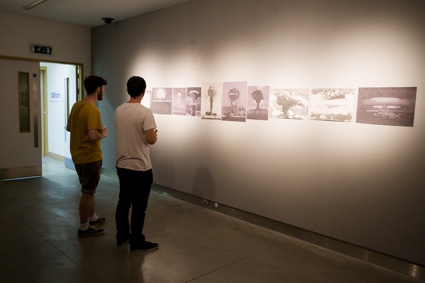 Drawings by Breda Lynch. Photo ©Joseph Carr
Drawings by Breda Lynch. Photo ©Joseph Carr
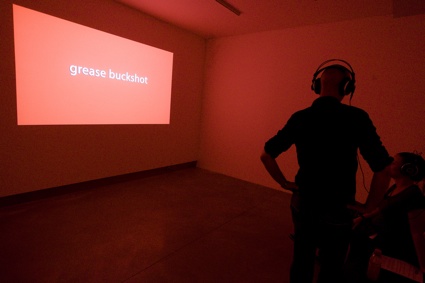 Fergal Brennan, ‘Italian for Beginners. Photo ©Joseph Carr
Fergal Brennan, ‘Italian for Beginners. Photo ©Joseph Carr
Fergal Brennan‘s ‘Italian for Beginners’ could also be called “Gaeilge, English for Italian beginners” which would clearly be clumsier and far less seducing. Brennan’s video is certainly as funny as the Danish film of 2000.
Brennan asked Italian people who live in Dublin to read out loud names of famous shop fronts. Some of these words are in Gaeilge, others are in English. The words then appear as phonetic deconstructions of three languages – Gaeilge, English and Italian- on the screen. The result is hilarious and mesmerizing. It reflects the multicultural city that Dublin has become. You walk down the street and meet people who were brought there by economic interests ranging from tourism to job opportunities. Yet in Dublin like in most major European cities, the language that unite passersby is english. It might be distorted, mangled and barely recognizable but (thanks to the unflappable patience of people whose main language is english) it is still english, the lingua franca of the contemporary economy.
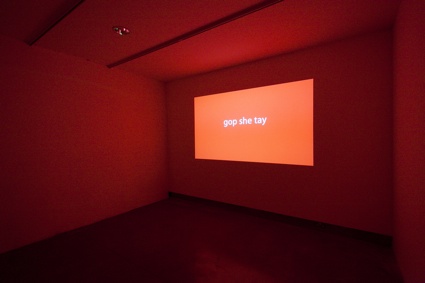 Fergal Brennan, ‘Italian for Beginners. Photo ©Joseph Carr
Fergal Brennan, ‘Italian for Beginners. Photo ©Joseph Carr
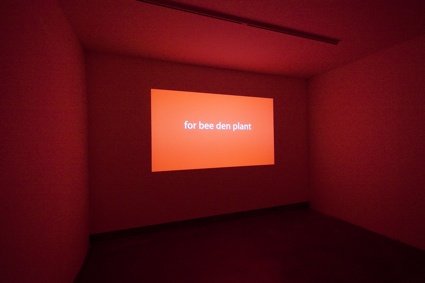 Fergal Brennan, ‘Italian for Beginners. Photo ©Joseph Carr
Fergal Brennan, ‘Italian for Beginners. Photo ©Joseph Carr
More images from the show.
GLITCH 2014. Cash Rules Everything Around was curated by Nora O Murchú. The exhibition remains opens until 19 July at RUA RED in Tallaght, just outside Dublin.
